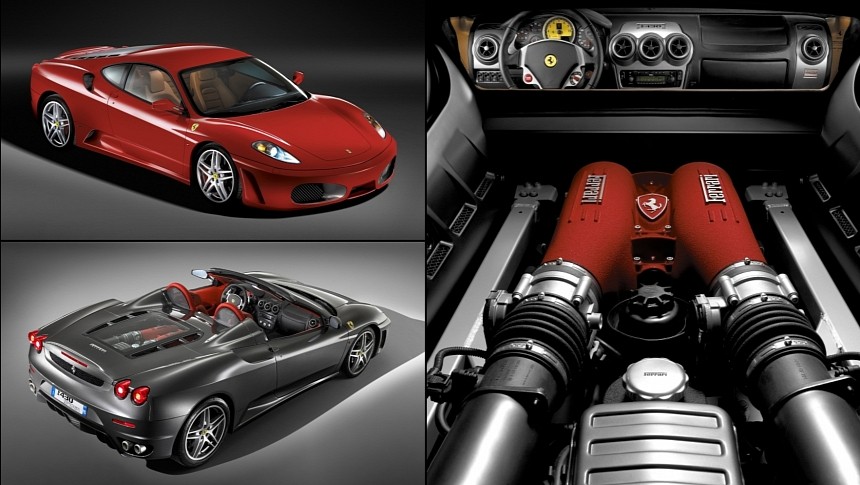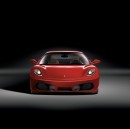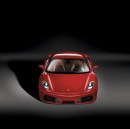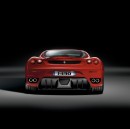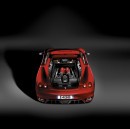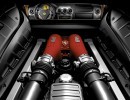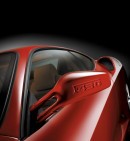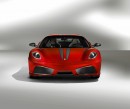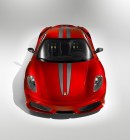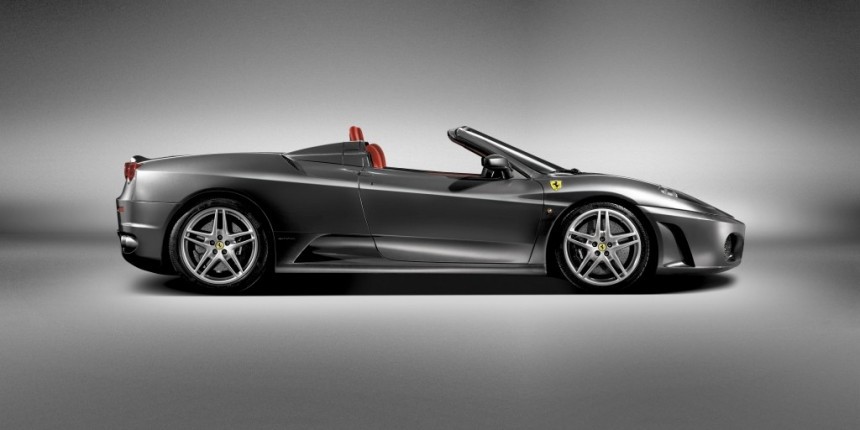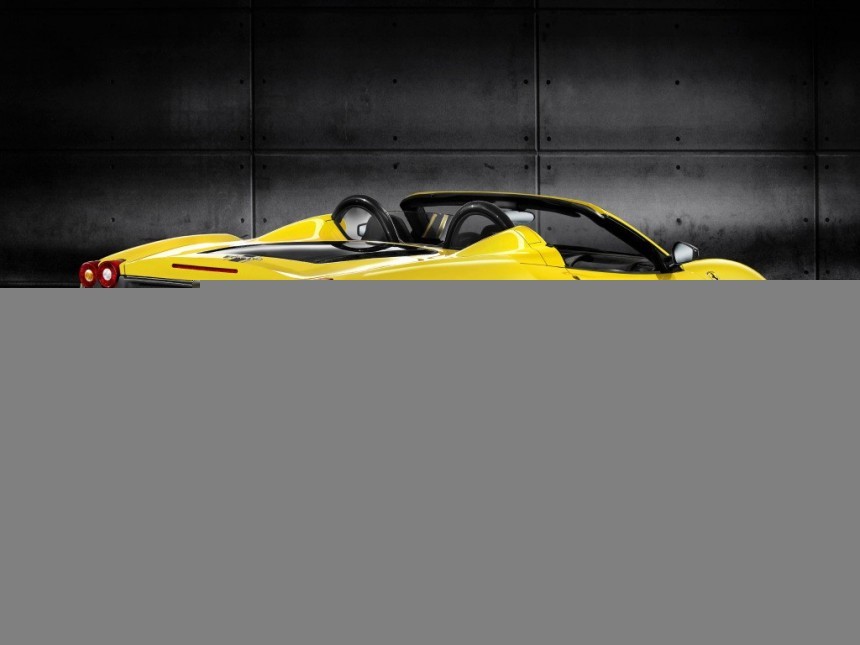Revealed in March 1999 at the Geneva Motor Show, the 360 is Prancing Horse's final Dino V8-engined model. A little over 17,600 units were produced through 2004, a lot by Ferrari standards. Penned by Frank Stephenson of Ford Escort RS Cosworth and Maserati MC12 fame, the F430 sold worse than its predecessor. More on the hotly contested grand total later...
Closely related to the 360 rather than being designed from the ground up, the 430 series went official in the form of a berlinetta in September 2004 at the Paris Motor Show. The nearly two-decade-old supercar looks the part even today, and it sounds far better than the F8 Tributo. Turbocharging is fine and all, especially in terms of how a force-fed engine builds torque. Aural pleasure favors the free-breathing variety because turbos need exhaust gases in order to do their job.
Little did we know back then, but the F430 was Ferrari's penultimate naturally-aspirated V8 mid-engine supercar. The 458 series closed that chapter in 2015 with the limited-run Speciale and Speciale A. Internally referred to as F131, the F430 is pretty similar to its forefather in regard to its lightweight aluminum space frame. The 355 and older midships used steel monocoques or good ol' tubular frames.
Ferrari says the F430 is 20 percent stiffer, therefore resulting in better handling. Be that as it may, the stiffness did come at a price. That price being a weight penalty of 60 extra kilograms, which converts to 132-odd pounds. Manufactured in Modena, the space frame is dimensionally similar to the previous-generation midship. The Maranello-based automaker went with 19-inch wheels rather than 18s, although the Prancing Horse retained the front and rear widths of the 360.
Measuring 7.5 inches up front and 10 inches out back, the lightweight alloys were originally joined by high-performance tires from Bridgestone. We're living in a day and age where Pirelli and Michelin are regarded as the crème de la crème, but remember that Bridgestone and Ferrari were joined at the hip a few years go. This partnership yielded remarkable outcomes in Formula 1, where the Scuderia was unbeatable with Michael Schumacher as the lead driver. Bridgestone is rumored to replace Pirelli as the Great Circus' tire supplier from 2025.
From the standpoint of suspension, double wishbones and electronically controlled adaptive dampers are fitted at every corner. The Skyhook damping system wouldn't mean a thing without beefy anti-roll bars fore and aft. Stopping power comes courtesy of light alloy four-piston calipers squeezing on 350-millimeter discs compared to 330 millimeters for the 360.
Ferrari claimed that 70 percent of parts that make up the F430 are new. The speed-sensitive power steering system is one of those parts, along with the F136 engine. A 90-degree V8 with a flat-plane crankshaft as opposed to the cross-plane crankshaft setup used by Maserati during that period, the F136 of the F430 could be specified with either a manual or an F1 gearbox.
First, second, third, fourth, and fifth are similar to the 360, whereas the final gear ratio is a tad longer. The Prancing Horse further improved the breed with a shorter final drive for better acceleration. Ferrari also redesigned the clutch with durability in mind. Assembled by Turin-based Graziano Trasmissioni (also known Dana Graziano since 2019), the F1 transmission isn't a dual-clutch affair. It's pretty much an improved version of the 360's automated manual, a gearbox with clever sensors and actuators doing both the clutch work and gear shifting.
The F136 boasts Formula 1-inspired cylinder heads and intake trumpets, along with a variable airflow plenum chamber and the variable valve timing system from the Enzo's magnificent V12. As a side note, the F140 engine continues to be produced as of June 2023, with displacement growing from 6.0 liters in the Enzo to 6.5 liters in the Purosangue and 812 Superfast.
Fed by two fuel tanks with a total capacity of 95 liters or 25 gallons, the 4,308-cc engine runs a compression ratio of 11.3:1 as opposed to 11.0:1 for the five-valve-per-cylinder V8 of the 360. The four-valve-per-cylinder F136 produces 490 metric ponies at 8,500 revolutions per minute, converting to 483 mechanical horsepower. Torque peaks at 5,250 spinnies to the tune of 465 Nm or 343 pound-feet, with 80 percent of the advertised torque available at 3,500 revolutions per minute.
Unveiled half a year after the fixed-head coupe, the soft-topped spider was presented with much pomp at the 2005 Geneva Motor Show. Structural reinforcements make the convertible 70 kilograms heavier than its berlinetta sibling, with Ferrari quoting 1,520 kilograms (3,351 pounds). A tenth of a second off the coupe and 3 miles per hour slower at full song, the spider could be optioned with leather on the roll-over bars.
Succeeding the 360 Challenge Stradale, the 430 Scuderia is best described as a stripped-out F430 with more power to boot. The spider is dubbed Scuderia Spider 16M, with no reference whatsoever to the 430 series. Why 16M, though? As you're well aware, the Scuderia is Formula 1's most successful constructor. Its 16th and final title came in 2008, when Lewis Hamilton won his first drivers' title by overtaking Timo Glock on the final corner of the final lap of the season's final race.
On that note, care to guess how many 430s were produced? Ferrari never shared this information with us plebs, yet many peeps agree on 14,000 to 15,000 units of the F430 and F430 Spider. The 430 Scuderia is believed to have numbered between 1,600 and 2,000 units. Advertised as a marriage of driving pleasure and performance, the Scuderia Spider 16M was strictly limited to 499 units. Ferrari asked $313,350 for one, which is $25,382 more than the 430 Scuderia and an eye-watering $78,553 more than the F430 Spider.
Little did we know back then, but the F430 was Ferrari's penultimate naturally-aspirated V8 mid-engine supercar. The 458 series closed that chapter in 2015 with the limited-run Speciale and Speciale A. Internally referred to as F131, the F430 is pretty similar to its forefather in regard to its lightweight aluminum space frame. The 355 and older midships used steel monocoques or good ol' tubular frames.
Ferrari says the F430 is 20 percent stiffer, therefore resulting in better handling. Be that as it may, the stiffness did come at a price. That price being a weight penalty of 60 extra kilograms, which converts to 132-odd pounds. Manufactured in Modena, the space frame is dimensionally similar to the previous-generation midship. The Maranello-based automaker went with 19-inch wheels rather than 18s, although the Prancing Horse retained the front and rear widths of the 360.
Measuring 7.5 inches up front and 10 inches out back, the lightweight alloys were originally joined by high-performance tires from Bridgestone. We're living in a day and age where Pirelli and Michelin are regarded as the crème de la crème, but remember that Bridgestone and Ferrari were joined at the hip a few years go. This partnership yielded remarkable outcomes in Formula 1, where the Scuderia was unbeatable with Michael Schumacher as the lead driver. Bridgestone is rumored to replace Pirelli as the Great Circus' tire supplier from 2025.
From the standpoint of suspension, double wishbones and electronically controlled adaptive dampers are fitted at every corner. The Skyhook damping system wouldn't mean a thing without beefy anti-roll bars fore and aft. Stopping power comes courtesy of light alloy four-piston calipers squeezing on 350-millimeter discs compared to 330 millimeters for the 360.
Ferrari claimed that 70 percent of parts that make up the F430 are new. The speed-sensitive power steering system is one of those parts, along with the F136 engine. A 90-degree V8 with a flat-plane crankshaft as opposed to the cross-plane crankshaft setup used by Maserati during that period, the F136 of the F430 could be specified with either a manual or an F1 gearbox.
First, second, third, fourth, and fifth are similar to the 360, whereas the final gear ratio is a tad longer. The Prancing Horse further improved the breed with a shorter final drive for better acceleration. Ferrari also redesigned the clutch with durability in mind. Assembled by Turin-based Graziano Trasmissioni (also known Dana Graziano since 2019), the F1 transmission isn't a dual-clutch affair. It's pretty much an improved version of the 360's automated manual, a gearbox with clever sensors and actuators doing both the clutch work and gear shifting.
The F136 boasts Formula 1-inspired cylinder heads and intake trumpets, along with a variable airflow plenum chamber and the variable valve timing system from the Enzo's magnificent V12. As a side note, the F140 engine continues to be produced as of June 2023, with displacement growing from 6.0 liters in the Enzo to 6.5 liters in the Purosangue and 812 Superfast.
Fed by two fuel tanks with a total capacity of 95 liters or 25 gallons, the 4,308-cc engine runs a compression ratio of 11.3:1 as opposed to 11.0:1 for the five-valve-per-cylinder V8 of the 360. The four-valve-per-cylinder F136 produces 490 metric ponies at 8,500 revolutions per minute, converting to 483 mechanical horsepower. Torque peaks at 5,250 spinnies to the tune of 465 Nm or 343 pound-feet, with 80 percent of the advertised torque available at 3,500 revolutions per minute.
Unveiled half a year after the fixed-head coupe, the soft-topped spider was presented with much pomp at the 2005 Geneva Motor Show. Structural reinforcements make the convertible 70 kilograms heavier than its berlinetta sibling, with Ferrari quoting 1,520 kilograms (3,351 pounds). A tenth of a second off the coupe and 3 miles per hour slower at full song, the spider could be optioned with leather on the roll-over bars.
Succeeding the 360 Challenge Stradale, the 430 Scuderia is best described as a stripped-out F430 with more power to boot. The spider is dubbed Scuderia Spider 16M, with no reference whatsoever to the 430 series. Why 16M, though? As you're well aware, the Scuderia is Formula 1's most successful constructor. Its 16th and final title came in 2008, when Lewis Hamilton won his first drivers' title by overtaking Timo Glock on the final corner of the final lap of the season's final race.
On that note, care to guess how many 430s were produced? Ferrari never shared this information with us plebs, yet many peeps agree on 14,000 to 15,000 units of the F430 and F430 Spider. The 430 Scuderia is believed to have numbered between 1,600 and 2,000 units. Advertised as a marriage of driving pleasure and performance, the Scuderia Spider 16M was strictly limited to 499 units. Ferrari asked $313,350 for one, which is $25,382 more than the 430 Scuderia and an eye-watering $78,553 more than the F430 Spider.
